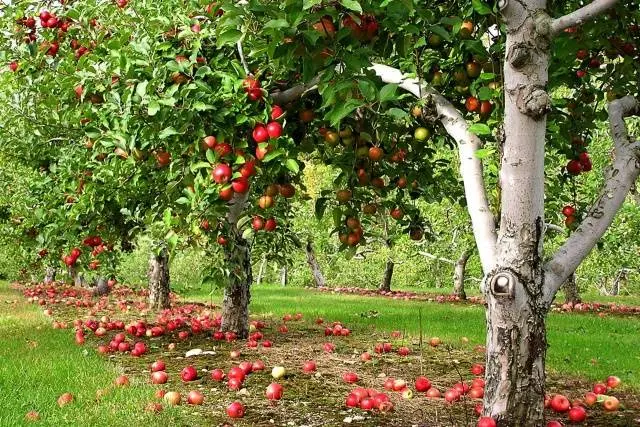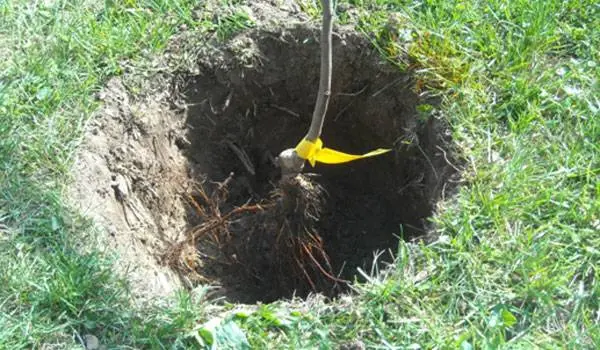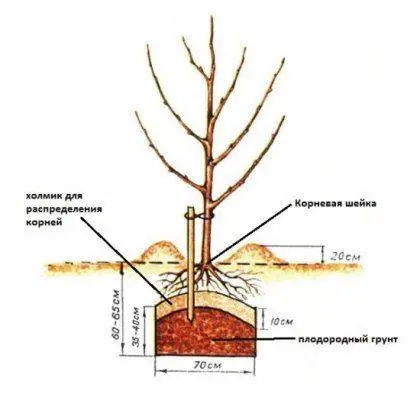Contents
An apple tree is a fruit tree that can traditionally be found in every garden. Fragrant and tasty fruits are grown even in the Urals, despite the harsh climate. For this region, breeders have developed a number of special varieties that are adapted to extremely low temperatures, sharp fluctuations in weather conditions and short summers. You can plant such apple trees not only in spring, but also in autumn, since they are not afraid of freezing. At the same time, planting apple trees in the fall in the Urals should be carried out at a certain time in compliance with certain rules, which we will discuss in detail later in the section.

The best varieties of apple trees for the Urals
When choosing an apple variety, you need to pay attention not only to the taste and aesthetic qualities of the fruit, but also to their ripening period, plant hardiness and its adaptability to frost. For the Urals, you can choose summer, autumn or winter varieties. In one garden, it is recommended to grow several apple trees at once with different periods of flowering and fruiting. This will allow, in case of unforeseen spring frosts, to preserve the harvest of at least one variety.
Speaking specifically, it is preferable to grow the following varieties of apples in the Urals:
- Apple tree Uralets was bred by breeders specifically for growing in harsh climatic conditions. The fruits of this variety ripen in early autumn (mid-September), are characterized by small size (weight only 50-60 g). The color of the apples is creamy, with a slight blush. The Uralets tree itself is vigorous, durable, highly resistant to severe frosts and diseases, pests. The disadvantage of the variety can be called a short period of storage of the crop, which is only 1,5 months.
- Variety name “Snowdrop” already speaks of late fruit ripening. Winter apples are very tasty, fragrant, reddish in color, and are characterized by medium size. The apple tree is undersized, up to 2 m high, perfectly adapted to adverse climatic conditions. Harvest apples can be stored for 4 months. The disadvantage of the variety is its low resistance to drought.
- Sweet and sour, yellow apple varieties “Ural bulk” ripen in mid-autumn. The variety is zoned for the Urals and is not afraid of any weather “surprises”. Medium-sized apple trees adapt well to new conditions and delight with fruits already 2 years after planting. You can store a rich harvest of this variety for 2 months after ripening. Among the shortcomings of the variety, small-fruitedness should be distinguished.
- “Silver Hoof” – This is a summer variety of apples, which is known in many regions of Our Country. It is famous for its excellent taste of fruits and unpretentiousness. The variety is not afraid of strong winter and spring frosts, is resistant to diseases. A medium-sized tree forms many branches, so it needs high-quality, regular pruning. The first fruiting occurs after 3-4 years from planting. The disadvantage of the variety is the low resistance to parasitism of the codling moth.

In addition to the varieties listed, apple trees “Persianka”, “Gift of Autumn”, “Summer Striped”, “Papirovka”, “Melba” and some others are suitable for the climate of the Urals. It should be noted that the famous “Antonovka” is also widely popular among gardeners in the Urals.
More information about some varieties of apple trees adapted to the Ural climate can be found on the video:
Conditions for growing apple trees
Having decided to grow an apple tree in the Urals, it is very important to correctly determine the best time for planting, choose a suitable plot in the garden and take care of creating a seat. We will try to understand all these nuances in more detail.
Optimal landing time
Most gardeners prefer to plant apple trees in the Urals in early spring (late April). The absence of frost and a large amount of moisture favorably affect the survival of the plant. However, there is nothing “terrible” in the autumn planting of apple trees.

It is necessary to plant fruit trees in the Urals within strictly defined terms, since early planting of an apple tree will cause untimely awakening of the kidneys, late planting will subject the plant to freezing. Thus, the optimal time for planting apple trees in the fall is at the beginning of October.
Choosing the right place in the garden
It is recommended to grow apple trees on a sunny plot of land where there is no access to strong northerly winds. The relief of the site should preferably be with a slight slope to remove excess moisture. It will not be possible to grow apple trees in the lowlands, since the root system of the plant will be subject to decay. For the same reason, special attention should be paid to the location of groundwater:
- If groundwater is deeper than 7 meters from the surface of the earth, then tall apple trees can be planted.
- If groundwater is at a level of 3-4 m from the surface of the earth, then dwarf and undersized varieties should be preferred.

If necessary, artificial drainage in the form of a drainage ditch or reservoir can be provided on the site.
Choosing a good seedling
When buying an apple tree seedling, you need to pay attention to its varietal characteristics and some external signs of quality. So, you can define the following rules for choosing seedlings:
- You should choose varieties of apple trees that are zoned for the Urals or have a high level of frost resistance.
- It is recommended to buy seedlings in gardening or nurseries.
- When choosing planting material, preference should be given to seedlings 1 year old (such trees do not have branches) or 2 years old (seedlings with 2-3 branches). Young apple trees adapt to new conditions faster and are more likely to successfully take root.
- Seedlings with an open root system should be carefully examined. The roots of the apple tree should have a healthy appearance without thickening, unevenness and a length of 30 cm. On the cut, the color of the spine should be white. A gray tint indicates freezing or rotting.
- The shoot of the apple tree should be even, without cracks and growths. Under the top layer of thin bark, when scraped off, you can see the green skin of the plant.

The listed signs will help you choose from a huge variety of seedlings only the best, healthy apple trees for your garden.
soil for apple trees
The varieties of apple trees listed above are distinguished not only by high frost resistance, but also by unpretentiousness. All of them can grow on different types of soil. At the same time, preference during planting of apple trees should be given to fertile soil with a high content of organic matter. It is important to remember that nitrogen is essential for a plant during the period of active growth. In the future, the quality and quantity of apples will be directly affected by the presence of potassium and phosphorus.
How to plant an apple tree in autumn
You need to take care of planting an apple tree 2-3 weeks before the seedling is bought. Already at this time, it is necessary to determine the place of cultivation and begin preparing the landing pit. The diameter of the hole should be approximately 90-110 cm, its depth should be 60-80 cm. After digging the hole, the following steps must be taken:
- Fill the hole with nutrient soil with the addition of compost, manure (rotted) or peat. If desired, you can combine all of the listed components in equal proportions. If heavy clay soil prevails on the site, then sand must be included in the composition of the nutrient substrate. In autumn, fallen leaves can be added to the bottom of the planting pit, which, in the process of decomposition, will become organic fertilizer.
- The nutrient soil that filled the pit should be watered abundantly and left alone for 2-3 weeks. When subsidence, the amount of nutrient substrate should be replenished.
- After 2 weeks, you can proceed directly to planting an apple tree. To do this, in the still loose soil, you need to make a small hole, corresponding in size to the dimensions of the roots.
- Set a peg in the center of the hole, then place the seedling, gently straightening its roots. Planting depth should be such that the root neck of the tree after compacting the soil is 5 cm above ground level.
- The soil around the entire perimeter of the pit needs to be compacted, the trunk of the apple tree is tied to a peg.
- After planting, a young seedling should be watered abundantly, using 20-40 liters per fruit tree. The soil on the trunk circle must be mulched with peat or humus.
The only mineral that an apple tree needs at an early stage of development and rooting is phosphorus. It can be added to the soil in the form of superphosphate.

You can see the entire landing sequence and emphasize for yourself some important points of the work from the video:
If there are other fruit trees in the garden or if several apple trees are planted at once, the recommended distances between plants should be observed. So, tall trees cannot be placed closer than 6 m, for medium-sized varieties this distance can be reduced to 4 m, and dwarf and undersized trees will feel good at a distance of 2,5-3 m from each other. Keeping a distance allows you to maximize the opening of fruit trees for the penetration of sunlight, provides full air circulation, and increases crop yields.
Preparing a seedling for a harsh winter
The choice of a frost-resistant variety for planting is only one of the prerequisites for the successful cultivation of apple trees in the Urals. After all, if you plant a young apple tree in the fall, it may not even survive the first harsh winter at all. In order to save a young fruit tree, you need to take care of following some rules:
- It is forbidden to prune a young seedling after planting in the fall.
- A fruit tree after planting before the onset of frost needs abundant watering.
- You can protect the fruit tree from parasites and diseases with a chalk solution. They are coated with the trunk of a young apple tree a few weeks after planting.
- The tree trunk must be insulated (tied with burlap). At the foot of the fruit tree, you need to put spruce branches with a dense carpet, which will become a protection against freezing and parasitism of rodents.
- Apple tree branches should be covered with polyamide film. It will protect the plant from intense sunlight, which can burn the tree. The film can be removed from the apple tree after the first leaves begin to appear.
A set of such simple rules will protect a plant planted in the fall from freezing, pathogenic bacteria and rodents. In subsequent years, care for the apple tree will consist of watering and loosening the soil, fertilizing and pruning the crown.

Being a gardener in the Urals is quite difficult: capricious weather, cold and short summers, harsh winters. It is this “set of arguments” that scares many owners away from planting an orchard in their yard. But growing your own, natural and very tasty apples in such a climate is quite possible if you know how to plant plants, how to protect them from the cold and take care of them. The information offered above allows you to successfully plant apple trees in the fall so that with the advent of spring their root system is adapted to new conditions, and the fruit tree itself develops fully and in a timely manner, without delays and lags in growth.









